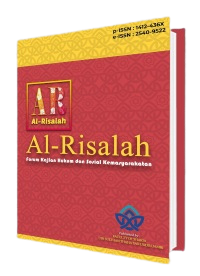Specialized Rehabilitation of Military Personnel Convicted of Narcotics Crimes: A Normative Legal Study
DOI:
https://doi.org/10.30631/alrisalah.v21i2.917Keywords:
Rehabilitation, Members of the Military, Offenders, Narcotics, FiredAbstract
This study focuses on the specialized rehabilitation of military personnel who have been convicted of narcotics crimes. Its aim was to comprehend the meaning, urgency, and concept of rehabilitating individuals within the military who have been found guilty of such crimes. To achieve this aim, the methodology used is normative legal study with statutory, contextual, case-based, and comparative approaches. Furthermore, the legal sources utilized consisted of both primary and secondary legislation. The results obtained from this study showed that rehabilitation for incarcerated military personnel involved in narcotic crimes corresponds to an endeavor aimed at providing exceptional rehabilitation specifically tailored to their circumstances. It is also important to note that the urgency of rehabilitation is closely related to the vested interest of the military in continuing the rehabilitation process, aligning with the initial recommendation. The state should, hence, give careful consideration to the implementation of specialized medical and social rehabilitation programs for military personnel who have been convicted of narcotic crimes. It is of utmost importance to establish a comprehensive framework within military agencies to facilitate the execution of medical and social rehabilitation measures for military members involved in narcotics offenses, including the necessary funding. In conclusion, the imposition of specialized rehabilitation measures, in conjunction with imprisonment, is essential for military personnel that are convicted of these crimes before their reintegration into society. This approach makes the state responsible for addressing the repercussions of their actions and providing tailored rehabilitation support to prevent any lingering resentment, minimize the risk of their recruitment by adversaries of the state, and enable their potential contributions if required in the future.
Downloads
References
Journals
Afrizal, Riki, and Upita Anggunsuri. “Optimizing Assessment Process to Drug User Within the Scope of Effective Medical and Social Rehabilitation for Drug Addicts.” Jurnal Penelitian Hukum De Jure 19, no. 3 (2019): 259–68.
Chandra, Erika Magdalena. “Victimless Crime in Indonesia : Should We Punished Them ? Kejahatan Tanpa Korban Di Indonesia : Haruskah Kita Menghukumnya ? A . Introduction According to Joseph F . Winterscheid in His Article Victimless Crimes : The Threshold Question and Beyond , the D.” PJIH 6, no. 2 (2019): 216–32. http://jurnal.unpad.ac.id/pjih/article/view/22214/11644.
Hawkins, Robert B, and Elizabeth T Rogawski Mcquade. “Cost-Effectiveness of Postoperative Drug Rehabilitation for Injection Drug Users.” The Annals of Thoracic Surgery, 2020. https://doi.org/10.1016/j.athoracsur.2019.11.011.
Lenggong, Ruslan, and Baso Madiong. “Effectiveness of Narcotics Addicts, Psychotropic, and Other Addictive Substances in Makassar State Class Detention Houses.” Indonesian Journal of Legality of Law 1, no. 1 (2018): 46–54. https://postgraduate.universitasbosowa.ac.id/.
Mahaseth, Harsh, and Ayushi Bansal. “ASIA AND THE ICC : THE DEVELOPMENT OF INTERNATIONAL CRIMINAL LAW.” ICLR: International and Comparative Law Review 21, no. 2 (2021): 923–28. https://doi.org/10.2478/iclr-2021-0017.
Mulyadi, Hendra. “Prajurit Yang Terlibat Tindak Pidana Narkotika.” Jurnal Cendekia Hukum 4, no. 2 (2019): 264. https://doi.org/10.3376/jch.v4i2.102.
Otto Yudianto, Fasichatus Sakdiyah, Erny Herlin Setyorini. “Model Double Track System Pidana Terhadap Pelaku Penyalahgunaannarkotika Menurut Undang-Undang Nomor 35 Tahun 2009.” Jurnal Yustitia 22, no. 1 (2021). https://doi.org/10.53712/yustitia.v22i1.1116.
Prendki, Virginie, Noam Tau, Tomer Avni, Marco Falcone, Angela Huttner, and Laurent Kaiser. “A Systematic Review Assessing the Under- Representation of Elderly Adults in COVID- 19 Trials.” BMC Geriatrics 20, no. 1 (2020): 1–10. https://bmcgeriatr.biomedcentral.com/articles/10.1186/s12877-020-01954-5.
Sulaiman, W M S Wan, Z Ismail, W S Wan Sulaiman, and R M Kawangit. “Dataset Relating Self-Control and Hope among Participants in Malaysian Rehabilitation.” Data in Brief 35 (2021): 106890. https://doi.org/10.1016/j.dib.2021.106890.
Yani, E Indra, and Aji Titin Roswitha Nurshanty. “Penegakan Hukum Tindak Pidana Penyalahgunaan Narkotika Yang Dilakukan Oleh Pihak Berwajib(Kepolisian Maupun Anggota Militer).” Jurnal Ilmu Hukum The Juris 5, no. 2 (2021): 183. http://ejournal.stih-awanglong.ac.id/index.php/juris/article/view/287/220.
Books
Arief, Barda Nawawi. Bunga Rampai Kebijakan Hukum Pidana Perkembangan Konsep KUHP Baru. 1st ed. Jakarta: Kencana Prenadamedia Grub, 2008.
Ekaputra, Mohammad, and Abul Khair. Sistem Pidana Di Dalam KUHP Dan Pengaturannya Menurut Konsep KUHP Baru. Medan: USU Press, 2010.
Theses/Dissertation
Dofir, Muhamad. “Sistem Peradilan Pidana Dalam Rangka Menanggulangi Penyalah Guna Narkotika.” Universitas Airlangga Surabaya, 2015.
Hoeda, Syamsoel. “Pidana Pemecatan Dari Dinas Militer Terhadap Prajurit Penyalah Guna Narkotika.” Universitas Negeri Jember, 2020.
Laws
Central government. Law (UU) No. 26 of 1997. Indonesia, issued 1997.
———. Law No. 35 of 2009 concerning Narcotics. Indonesia, issued 2009. https://peraturan.bpk.go.id/Home/Details/38776/uu-no-35-tahun-2009.
———. Law Number 3 Pnps of 1965 concerning the application of the Military Criminal Code, the Military Criminal Procedure Code and the Military Disciplinary Law for members of the Police force (State Gazette of the Republic of Indonesia of 1965 Number 21 in addition to State Gazette Number 2737) se. Indonesia, issued 1965.
———. Law Number 31 of 1997 concerning Military Courts, State Gazette of the Republic of Indonesia of 1997 Number 84, Supplement to State Gazette of the Republic of Indonesia Number 3713, hereinafter referred to as the Law on Military Courts). Indonesia, issued 1997.
———. Law Number 34 of 2004 concerning the Indonesian National Armed Forces. Indonesia, issued 2004.
———. Law Number 39 of 1947 concerning Adjusting the Military Criminal Code (Staatsblad 1934, Number 167) to the Present Situation (hereinafter referred to as the Military Criminal Code or the Military Criminal Code or abbreviated KUH. Indonesia, issued 1947.
———. Law Number 48 of 2009 Concerning Judicial Powers (State Gazette of the Republic of Indonesia of 2009 Number 157, Supplement to State Gazette of the Republic of Indonesia Number 5076 hereinafter referred to as the Judicial Powers Law). Indonesia, issued 2009.
———. Law Number 6 of 1950 concerning the Stipulation of an Emergency Law concerning Criminal Procedures in Military Courts as a Federal Law (State Gazette of the Republic of Indonesia of 1950 Number 35) as amended and supplemented by Law Number 1. Jakarta, issued 1950.
———. Law of the Republic of Indonesia Number 35 of 2009 concerning Narcotics (State Gazette of the Republic of Indonesia of 2009 Number 143, Supplement to State Gazette of the Republic of Indonesia Number 5062 hereinafter referred to as the Narcotics Law and abbreviated as the Narcotics Law. Indonesia, issued 2009.
Downloads
Published
How to Cite
Issue
Section
License
Copyright (c) 2021 Diana Alfianti, M. Arief Amrullah, Fanny Tanuwijaya, Hari Utomo

This work is licensed under a Creative Commons Attribution-ShareAlike 4.0 International License.

This work is licensed under a Creative Commons Attribution-ShareAlike 4.0 International License.












